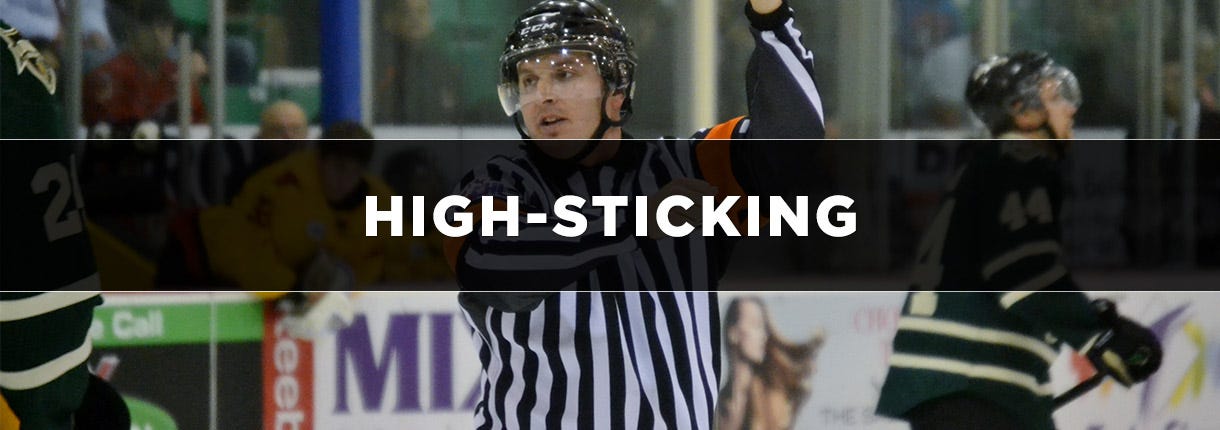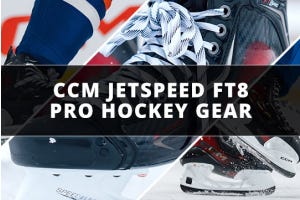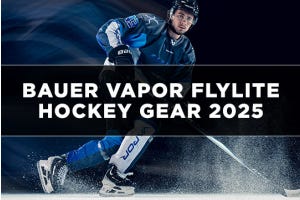High-Sticking Penalty: Rule Details for Hockey’s High-Stick Infraction

Throughout the years, the game of Ice Hockey has gotten much faster. This leads to exciting goals, highlight-reel saves, and so on. That said, the game has put an emphasis on trying to protect its players, focusing especially on head injuries. One rule that has looked to prevent head injuries is the High-Sticking Rule. This article will explain just what High-Sticking is, and what is and is not considered a High-Sticking penalty.
- What is High-Sticking?
- NHL High-Sticking: Major vs. Minor Penalty
- High-Sticking & Where the Puck Hits
- High-Sticking Goals
What is High-Sticking?
High-Sticking is the name of an infraction when a player accidentally, or intentionally, makes contact with an opposing player above his shoulders. This typically takes place when two players are battling for a puck, one gains possession of it, and the opposing player will try to take it away via a stick-lift. Sometimes the stick-lift will miss and make contact with a player’s head. Following that, a High-Sticking penalty will be called.
How High Can a Hockey Stick Go?
The general rule of thumb for how high a hockey stick can legally go is shoulder height. If a players stick makes contact with an opposing player above the shoulders, a High-Sticking penalty will be called. If a player makes contact with the puck while it is above the shoulders, the play will be stopped, and a faceoff will take place where the infraction occurred.
NHL Rule #60.2
NHL Rule #60.2 states that a minor penalty for High Sticking is called when the stick of a player makes contact with a player above the height of the shoulders. A minor penalty of two minutes will be assessed to the player responsible.
NHL Rulebook Text
“A “high stick” is one which is carried above the height of the opponent’s shoulders. Players must be in control and responsible for their sticks. However, a player is permitted accidental contact on an opponent if the act is committed as a normal wind up or follow through of a shooting motion, or accidental contact on the opposing center who is bent over during the course of a face-off. A wild swing at a bouncing puck would not be considered a normal wind up or follow through and any contact with an opponent above the height of the shoulders shall be penalized accordingly.”
NHL Rule #60.4
NHL Rule 60.4 discusses match penalties. Sometimes a match penalty can be assessed for High-Sticking. In the opinion of the referee determines that a player used his stick to intentionally injure a player of the opposing team, the referee will issue a match penalty to the offending player, which results in them not being able to play for the rest of the game.
NHL Rulebook Text
“When, in the opinion of the Referee, a player attempts to or deliberately injures an opponent while carrying or holding any part of his stick above the shoulders of the opponent, the Referee shall assess a match penalty to the offending player.”
NHL High-Sticking: Major vs. Minor Penalty
Minor Penalties are called when a player accidentally makes contact with an opposing player above the shoulders. Minor penalties are two minutes in length. Major Penalties can also be called when a High-Sticking infraction takes place. A major can be called if the referee determines that the guilty player used his stick to intentionally harm the opposing player. The main indication of whether or not a Major Penalty should be assessed is if there is blood. If the player who was hit is bleeding, this will usually result in a major penalty being called on the guilty player. This will result in a penalty ranging from two to five minutes, in which the guilty player is not allowed to leave the penalty box, regardless of if the opposing team scores a goal.
High-Sticking & Where the Puck Hits
Regarding High-Sticking, where the puck makes contact with the stick prior to a goal is very important. For example, if a player has his stick above his shoulders, but the puck hits the portion of the stick that is below his shoulders, and goes into the net, the goal would count.
This also applies to situations where the puck doesn’t go in the net. If a player attempts to play the puck in the air and uses his stick to bat it down while it is above his shoulders, the play will halt. A faceoff will take place, although no penalty will be called.
High-Sticking Goals
If the stick makes contact with the puck, while the puck is above the shoulders, and goes into the opponent’s net, it is considered no-goal. No penalty will be assessed here, but a faceoff would come out of the offensive zone and into the neutral zone. However, if the pucks point of contact with the stick is below the shoulders, regardless of if the stick itself is above, and goes into the net, the goal will count.











